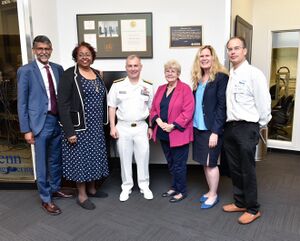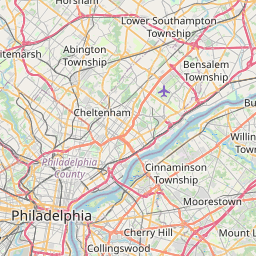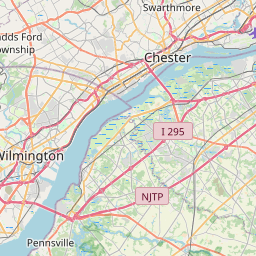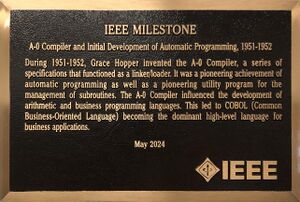Milestones:A-0 Compiler and Initial Development of Automatic Programming, 1951-1952
- Date Dedicated
- 2024/05/07
- Dedication #
- 250
- Location
- Philadelphia, PA
- IEEE Regions
- 2
- IEEE sections
- Philadelphia
- Achievement date range
- 1952-1959

Title
A-0 Compiler and Initial Development of Automatic Programming, 1951-1952
Citation
During 1951-1952, Grace Hopper invented the A-0 Compiler, a series of specifications that functioned as a linker/loader. It was a pioneering achievement of automatic programming as well as a pioneering utility program for the management of subroutines. The A-0 Compiler influenced the development of arithmetic and business programming languages. This led to COBOL (Common Business-Oriented Language) becoming the dominant high-level language for business applications.
Street address(es) and GPS coordinates of the Milestone Plaque Sites
Univ. of Pennsylvania Moore School Bldg.: 200 S. 33rd St. (corner of 33rd St and Walnut St.), Philadelphia, PA 19104 US, (39.95239, -75.190489)
Details of the physical location of the plaque
Upon entering the building lobby from the S. 33rd St. entrance, walk forward (west) through the corridor and the wall-mounted plaque will be visible through the glass front of a suite on the right side.
How the plaque site is protected/secured
Security cameras and campus security guards.
Historical significance of the work
The historical significance of the compiler is the importance of how it affected the modern computer: A compiler is a computer program that translates computer code written in mathematical programming into a computer language such as English. The compiler is primarily used for programs that translate source code from a high-level programming language to a lower-level language to create an executable program.[1]
The invention of the compiler led to the Information Age and the beginning of the IT industry.
Grace Hopper was one of the first programmers of the Harvard Mark I computer. She was a pioneer of computer programming, and she invented and coined the term "compiler." Hopper popularized the idea of machine-independent programming languages. In 1957, FLOW-MATIC was used in the UNIVAC, the first commercial computer. Flow-Matic led to the development of COBOL, patented in 1960. Her work also led to the implementation of standards for testing computer systems and components, most significantly for early programming languages such as FORTRAN and COBOL. Hopper worked on many teams and programs, her inventions were promoted/demonstrated by many lecturers at the University of Pennsylvania, and she was often referred to as “Amazing Grace.” She retired from the Navy as Rear Admiral, and her importance is widely recognized and appreciated worldwide.
Obstacles (technical, political, geographic) that needed to be overcome
The biggest obstacle that needed to be overcome was convincing the management and the computer department that the Compiler would work technically. The challenges of convincing the upper management audience took two years for acceptance. “I had a running compiler, and nobody would touch it… they carefully told me computers could only do arithmetic. They could not do programs” said Grace Hopper.[2][3]
Features that set this work apart from similar achievements
The feature that set the compiler apart from similar achievements is it was the missing link in computer programming. The compiler was an executable program that translated source code into a binary form known as object code or machine code for the first time. [4]
Significant references
Additional references
- https://www.computinghistory.org.uk/det/5487/Grace-Hopper-completes-the-A-0-Compiler/
- https://www.computinghistory.org.uk/det/6293/COBOL-is-introduced/
- https://news.yale.edu/2017/02/10/grace-murray-hopper-1906-1992-legacy-innovation-and-service
- https://www.computer.org/profiles/grace-hopper
- https://en.wikipedia.org/wiki/Grace_Hopper
- https://www.computinghistory.org.uk/det/5487/Grace-Hopper-completes-the-A-0-Compiler/
- https://www.computinghistory.org.uk/det/6293/COBOL-is-introduced/
- https://www.britannica.com/biography/Grace-Hopper
- https://www.computer.org/csdl/magazine/it/2015/01/mit2015010062/13rRUxCitFF (IEEE)
- https://www.computinghistory.org.uk/det/5487/Grace-Hopper-completes-the-A-0-Compiler/
- https://www.computinghistory.org.uk/det/6293/COBOL-is-introduced/
- https://dl.acm.org/doi/pdf/10.1145/800025.1198367
Supporting materials
- June 1957 Grace Hopper photo and story: https://www.hagley.org/research/news/hagley-vault/were-posting-photograph-june-1957-today
- 1967 Grace Hopper photo and story: https://www.hagley.org/research/news/hagley-vault/we-re-posting-ca-1967-photograph-today-recognition-115th-anniversary
- Grace Hopper profile: https://blog.cis.upenn.edu/grace-murray-hopper-pioneering-the-digital-frontier/
- Capt. Hopper's Future Possibilities: Data, Hardware, Software, and People lecture of Aug. 26, 1982
- IEEE Spectrum story: From Punch Cards to Python: Grace Hopper’s A-0 compiler paved the way for modern programming languages
Map













